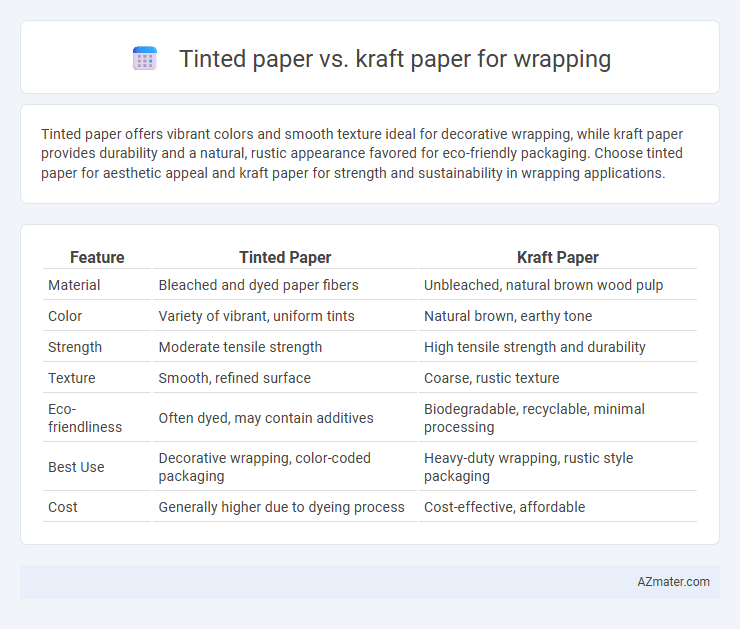Tinted paper offers vibrant colors and smooth texture ideal for decorative wrapping, while kraft paper provides durability and a natural, rustic appearance favored for eco-friendly packaging. Choose tinted paper for aesthetic appeal and kraft paper for strength and sustainability in wrapping applications.
Table of Comparison
| Feature | Tinted Paper | Kraft Paper |
|---|---|---|
| Material | Bleached and dyed paper fibers | Unbleached, natural brown wood pulp |
| Color | Variety of vibrant, uniform tints | Natural brown, earthy tone |
| Strength | Moderate tensile strength | High tensile strength and durability |
| Texture | Smooth, refined surface | Coarse, rustic texture |
| Eco-friendliness | Often dyed, may contain additives | Biodegradable, recyclable, minimal processing |
| Best Use | Decorative wrapping, color-coded packaging | Heavy-duty wrapping, rustic style packaging |
| Cost | Generally higher due to dyeing process | Cost-effective, affordable |
Introduction to Tinted Paper and Kraft Paper
Tinted paper features a subtle hue achieved through dyeing or pigment infusion, making it ideal for visually appealing and customized wrapping projects. Kraft paper is a sturdy, unbleached brown paper known for its durability and eco-friendly qualities, commonly used in packaging and gift wrapping. Both materials offer unique aesthetics and functional benefits, with tinted paper providing color variety and kraft paper emphasizing strength and recyclability.
Key Differences Between Tinted and Kraft Paper
Tinted paper offers a wide range of vibrant colors and smooth textures, making it ideal for decorative wrapping with a polished appearance, while Kraft paper is known for its natural brown color, durability, and eco-friendly properties, perfect for rustic or heavy-duty packaging. Tinted paper is generally thinner and less resistant to tearing compared to the thicker, more robust Kraft paper, which provides better protection for heavier items. The biodegradability of Kraft paper aligns with sustainable packaging goals, whereas tinted paper often requires coatings or dyes that may affect its environmental impact.
Appearance and Aesthetic Appeal
Tinted paper offers vibrant color options that enhance the visual appeal of wrapped items, creating a modern and polished look ideal for gifts and retail packaging. Kraft paper provides a rustic, natural aesthetic with its brown, textured surface, appealing to eco-conscious brands and those seeking an organic, handcrafted appearance. Both papers can be customized with printing or embellishments, but tinted paper excels in bold color presentation while kraft paper emphasizes simplicity and warmth.
Strength and Durability Comparison
Tinted paper offers moderate strength suitable for lightweight wrapping, with some resistance to tearing but less durability under heavy stress or moisture exposure. Kraft paper, made from strong wood fibers, provides superior durability and tensile strength, making it ideal for wrapping heavier or rougher items requiring protection. The moisture resistance and tear strength of Kraft paper significantly outperform tinted paper, ensuring reliable performance in demanding packaging applications.
Environmental Impact and Sustainability
Tinted paper and kraft paper vary significantly in environmental impact and sustainability, with kraft paper being more eco-friendly due to its unbleached, biodegradable nature and lower chemical processing requirements. Kraft paper often comes from sustainably managed forests and is easier to recycle, reducing landfill waste compared to tinted paper, which frequently involves additional dyes and coatings that can complicate recycling processes. Choosing kraft paper for wrapping supports sustainability goals by minimizing chemical use, enhancing compostability, and improving overall environmental footprint.
Cost Analysis: Tinted Paper vs Kraft Paper
Tinted paper generally costs more than kraft paper due to the additional dyeing process and color additives required, making kraft paper a more budget-friendly option for bulk wrapping needs. Kraft paper's natural brown hue and simpler manufacturing process result in lower production expenses, providing significant cost savings for businesses focused on eco-friendly packaging. When evaluating cost-efficiency, kraft paper offers a more economical solution without sacrificing durability or quality, while tinted paper caters to niche markets requiring aesthetic customization at a premium price.
Printing and Customization Options
Tinted paper offers vibrant color bases that enhance printed designs, making it ideal for visually striking wrapping with sharp text and intricate patterns. Kraft paper provides a natural, rustic texture that absorbs ink differently, resulting in a more subdued, vintage look suitable for logos and simple graphics. Both materials support custom printing techniques like digital, screen, and foil stamping, but tinted paper generally yields higher contrast and color fidelity.
Best Uses for Tinted Paper in Wrapping
Tinted paper offers vibrant colors and a smooth texture ideal for gift wrapping, enhancing visual appeal and creating a polished presentation for special occasions like birthdays, weddings, and holidays. It provides excellent opacity, preventing the contents from showing through while allowing for creative layering effects with ribbons and other decorative accents. Unlike Kraft paper, tinted paper is better suited for delicate or formal packaging where aesthetics and color variety are paramount.
Ideal Applications of Kraft Paper for Wrapping
Kraft paper is ideal for wrapping heavy or bulky items due to its sturdy and durable fiber composition, providing reliable protection during transit. Its natural brown hue and eco-friendly properties make it perfect for rustic-themed or sustainable packaging, enhancing brand appeal in organic or artisanal markets. Kraft paper's versatility extends to cushioning fragile goods and serving as a recyclable alternative, making it preferred for environmentally conscious businesses.
Choosing the Right Wrapping Paper for Your Needs
Choosing the right wrapping paper depends on the desired aesthetic and durability; tinted paper offers vibrant colors and smooth textures ideal for decorative purposes, while Kraft paper provides a sturdy, eco-friendly option with a rustic, natural look. Tinted paper is suitable for delicate gifts that require a polished finish, whereas Kraft paper excels in protecting heavier items and supporting sustainable packaging practices. Consider factors such as environmental impact, strength, and presentation style to select the wrapping paper that best aligns with your specific needs.

Infographic: Tinted paper vs Kraft paper for Wrapping
 azmater.com
azmater.com